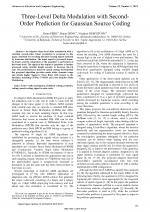| 3/2018 - 17 |
Three-Level Delta Modulation with Second-Order Prediction for Gaussian Source CodingPERIC, Z. |
| Extra paper information in |
| Click to see author's profile in |
| Download PDF |
Author keywords
delta modulation, Huffman coding, predictive coding, speech coding, signal to noise ratio
References keywords
coding(8), speech(6), adaptive(6), signal(5), modulation(5), delta(5), source(4)
Blue keywords are present in both the references section and the paper title.
About this article
Date of Publication: 2018-08-31
Volume 18, Issue 3, Year 2018, On page(s): 125 - 130
ISSN: 1582-7445, e-ISSN: 1844-7600
Digital Object Identifier: 10.4316/AECE.2018.03017
Web of Science Accession Number: 000442420900017
SCOPUS ID: 85052104039
Abstract
An adaptive three-level delta modulation with a switched second-order linear prediction is proposed in this paper, intended for encoding the time-varying signals modeled by Gaussian distribution. The input signal is processed frame-by-frame, and the adaptation of the quantizer is performed at the frame level. The signal at the output of quantizer is further processed using variable length encoder to decrease the bit rate. The performance is tested in speech coding, showing that the proposed algorithm provides much wider dynamic range and attains higher Signal to Noise Ratio with respect to the baselines, including CFDM, CVSDM and 2-bit Adaptive Delta Modulation. |
| References | | | Cited By |
Web of Science® Times Cited: 3 [View]
View record in Web of Science® [View]
View Related Records® [View]
Updated 2 days, 19 hours ago
SCOPUS® Times Cited: 3
View record in SCOPUS® [Free preview]
View citations in SCOPUS® [Free preview]
[1] Gaussian source coding based on variance‐mismatched three‐level scalar quantisation using Q ‐function approximations, Peric, Zoran, Denic, Bojan, Despotovic, Vladimir, IET Communications, ISSN 1751-8636, Issue 4, Volume 14, 2020.
Digital Object Identifier: 10.1049/iet-com.2019.0431 [CrossRef]
[2] Algorithm based on 2‐bit adaptive delta modulation and fractional linear prediction for Gaussian source coding, Peric, Zoran, Denic, Bojan, Despotovic, Vladimir, IET Signal Processing, ISSN 1751-9675, Issue 6, Volume 15, 2021.
Digital Object Identifier: 10.1049/sil2.12040 [CrossRef]
[3] Gaussian Source Coding using a Simple Switched Quantization Algorithm and Variable Length Codewords, PERIC, Z., PETKOVIC, G., DENIC, B., STANIMIROVIC, A., DESPOTOVIC, V., STOIMENOV, L., Advances in Electrical and Computer Engineering, ISSN 1582-7445, Issue 4, Volume 20, 2020.
Digital Object Identifier: 10.4316/AECE.2020.04002 [CrossRef] [Full text]
Disclaimer: All information displayed above was retrieved by using remote connections to respective databases. For the best user experience, we update all data by using background processes, and use caches in order to reduce the load on the servers we retrieve the information from. As we have no control on the availability of the database servers and sometimes the Internet connectivity may be affected, we do not guarantee the information is correct or complete. For the most accurate data, please always consult the database sites directly. Some external links require authentication or an institutional subscription.
Web of Science® is a registered trademark of Clarivate Analytics, Scopus® is a registered trademark of Elsevier B.V., other product names, company names, brand names, trademarks and logos are the property of their respective owners.
Faculty of Electrical Engineering and Computer Science
Stefan cel Mare University of Suceava, Romania
All rights reserved: Advances in Electrical and Computer Engineering is a registered trademark of the Stefan cel Mare University of Suceava. No part of this publication may be reproduced, stored in a retrieval system, photocopied, recorded or archived, without the written permission from the Editor. When authors submit their papers for publication, they agree that the copyright for their article be transferred to the Faculty of Electrical Engineering and Computer Science, Stefan cel Mare University of Suceava, Romania, if and only if the articles are accepted for publication. The copyright covers the exclusive rights to reproduce and distribute the article, including reprints and translations.
Permission for other use: The copyright owner's consent does not extend to copying for general distribution, for promotion, for creating new works, or for resale. Specific written permission must be obtained from the Editor for such copying. Direct linking to files hosted on this website is strictly prohibited.
Disclaimer: Whilst every effort is made by the publishers and editorial board to see that no inaccurate or misleading data, opinions or statements appear in this journal, they wish to make it clear that all information and opinions formulated in the articles, as well as linguistic accuracy, are the sole responsibility of the author.





